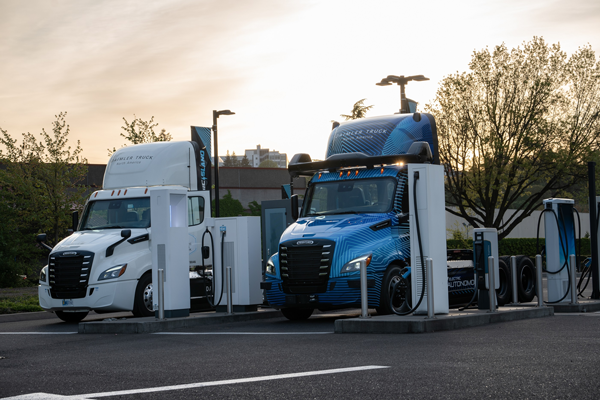
Daimler Truck has unveiled a zero emission Freightliner eCascadia truck with autonomous driving technology.
The technology demonstrator is based on a production battery-electric Freightliner eCascadia and is equipped with U.S. company Torc Robotics’ autonomous driving software and Level 4 sensor and compute technology. Torc Robotics is Daimler Truck’s independent subsidiary
for autonomous virtual driver technology.
The autonomous sensor suite and compute power is packaged to fit the smaller day cab configuration of the battery electric eCascadia. Customised software provides the autonomous system with control interfaces and feedback on vehicle status. Daimler says the in-house designed sensor bar cover, which incorporates cameras, lidar sensors and radar sensors, improves aerodynamic performance while also providing better protection from damage. Four additional 12-volt batteries provide power for uninterrupted operation.
While still a research and advanced engineering project, Daimler says the autonomous vehicle has the potential to evolve into a modular, scalable platform that is ‘propulsion agnostic’ for flexible use in different trucking applications. The goal, the company says, is to offer customers a choice of vehicles for their specific business and transportation needs.
“Together with Torc, we are making significant progress towards introducing autonomous trucks in the U.S. by 2027,” said Joanna Buttler, Head of Global Autonomous Technology Group at Daimler Truck, in a media release. “While we target autonomous trucks with conventional propulsion technology for this first market launch, we always look further into the future. We will employ an iterative approach to the development, testing and optimisation of autonomous-electric technology, while exploring the most promising use cases in collaboration with our fleet customers.”
Daimler says that in the current hub-to-hub application, the autonomous truck is driven between freight centres along U.S. highway corridors. In the future, charging infrastructure and autonomous freight hubs could be combined to charge and load simultaneously.
Source: Motor Trader e-Magazine (June 2024)
12 June 2024
